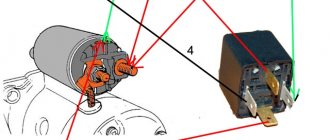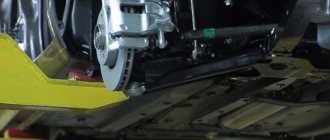Do-it-yourself primitive heating of the interior of any car in winter: current technologies
Fan heater
Those who like simple solutions will like additional means of heating the interior. Designing a car heater from a cigarette lighter with your own hands is one of the simple and affordable options for designing additional heating. The advantages of such a device are difficult to underestimate:
- Fuel and oxygen are not burned.
- Possibility of use in cars of any class.
- Compact design.
A similar solution is commercially available. Its name is a 12 Volt car fan heater. The main disadvantage is low efficiency: it cannot create a microclimate alone. It is recommended to use the car heater only as an addition to standard heating devices. Yours is more reliable and, moreover, repairable - all by analogy with winter washers: a homemade anti-freeze recipe is much better than a roadside canister of an unknown potion.
Ceramic oven
Using combustion gas as a heat source is an effective way to quickly raise the temperature to comfortable levels. The minimum elements are a ceramic stove and a 15-liter gas cylinder. The risk of fire and intense oxygen combustion limit the demand for this type of heating.
Modify the factory furnace
It is preferable to take the path of improving standard equipment, but the costs are incomparable. Modifying a heater is not an easy task: it requires skill and the elements are compact in size. It is not a fact that an additionally installed radiator will have an effect, since it is difficult for the fluid to warm up to operating temperature. Another thing is to introduce an electric heater from a diesel modification (RTS) - the effect is obvious. In addition, warm air flows immediately after starting the engine.
How to properly warm up the interior
Suzuki Escudo blue tank Logbook Power steering J20A H20A
Surprisingly, even experienced drivers do not always know how to use the stove correctly. Many manufacturers describe the procedure in detail in their operating instructions:
- Start the car and let the engine warm up.
- Select cabin recirculation mode. This may require pressing a button that will command the servo to close the external air intake curtains. In simpler trim levels, this function is performed by a lever on the dashboard, with which the driver blocks the access of cold air inside the cabin.
- Set the temperature control to the maximum heat setting. Thus, you completely open access to the coolant to the heat exchanger of the heating system.
- Turn on the stove fan at low speed. The warming up engine will soon begin to supply the radiator with warm antifreeze.
- As the engine temperature rises, you need to increase the fan speed. If the windows are frozen or fogged up, then you need to direct a stream of warm air onto them by selecting the appropriate position of the dampers.
- After the glass has thawed, you can choose a different direction for the hot air stream, more comfortable for the driver and passengers.
- When the interior has warmed up to the optimal temperature, it is necessary to turn off the recirculation mode, thus opening the access of fresh air inside the car.
Car heating
How to make a car heater with your own hands and power it from the cigarette lighter: instructions
The operating principle of fan heaters is based on the formation of a heat flow by blowing a heated body. The air flow is generated by a fan, and a ceramic heating element acts as a heat source. Previously, there were models with tubular electric heaters and nichrome spirals.
Selection of components
You can create additional heating for the car interior in winter using improvised means. One of the simple schemes includes components available to any inventor:
- IP65 electrical junction box which serves as housing.
- Nichrome spiral for a household electric oven, acting as a heating element.
- Two axial fans.
- Two terminal blocks for fastening sections of spirals and tying them with connecting wires.
- Wire with a cross-section of at least 2.5 mm2.
- Cigarette lighter connector.
- Switch button.
Spiral
When choosing a ferronichrome spiral element, you must be guided by its cross-section. It is not recommended to choose products with a diameter of more than 0.6 mm. The optimal diametrical characteristic is 0.6 mm - and can be easily found on sale, and the connection diagram is simple. We will adhere to this advice when designing the electrical part.
For your information. You can take a nichrome spiral from a toaster, microwave or convection oven by measuring its diameter and adjusting the design of the device.
Cooler
Small fans can handle the heat dissipation function. The specific size depends on the dimensions of the junction box. For example, for a box 88x88x60, two coolers 30x30x15 are suitable. Of course, the electric motor must be designed for 12 Volts.
Manufacturing
When creating a heater circuit for a car with your own hands, powered from a cigarette lighter, it is important to understand that its electrical resistance depends on the length of the section of the nichrome spiral, which affects the amount of current consumed and, as a result, the amount of heat emitted. The larger the length and cross-section, the lower the resistance of the conductor and the greater the power of the installation.
How to choose a car heater
Battery-powered or stand-alone heater? How to choose the right model? All potential buyers ask these questions.
In order to choose the right option, focus on the following criteria:
- Safety. It directly depends on the quality of the heating equipment and its power. Quality is determined primarily by the brand of the technical device, but it is important to correlate the power with the characteristics of the vehicle - a powerful device that quickly heats up the interior cannot be installed in the interior of a small car. This threatens a short circuit in the electrical system and a possible fire.
- Case material . Manufacturers use different materials: metal, plastic and ceramics. The last option is considered the safest and most durable. It is not subject to corrosion, is resistant to elevated temperatures and does not dry out the air even when it is heated to the maximum.
- A heating element. Tungsten electric spirals are considered obsolete. They were replaced by ceramic infrared elements and elements based on heating elements. The former are safe, but do not have a wide range of action. The latter are suitable for large areas and do not consume oxygen.
Total
Supplementing the standard interior heating in winter with a homemade car fan heater is one of the simple solutions. It is easier to implement than installing heated seats on a low-spec Lada Granta. The importance of a heating installation in creating an internal microclimate is exclusively auxiliary due to the low efficiency of such heating. The advantage over store-bought options is reliability, lower cost, and maintainability.
The product is assembled from nichrome spirals with a diameter of 0.6 mm, fans, terminal blocks, wires, a cigarette lighter connector and a button. Most of the elements fit into the case. Power is supplied from the cigarette socket. Current load – no more than 15 A. Effective power – about 150 W.
An alternative solution is to make a car heater from a hair dryer. The product’s motor is designed for 12 V. The heating elements will have to be cut into several sections and connected in parallel, having previously measured the current strength. The hair dryer should be connected exclusively via a relay.
Introduction
A homemade additional heater VAZ-2110 can heat the interior of a domestic vehicle even in the most severe frosts. In the article below, we will consider all the existing heating units that can be installed in the tenth VAZ model as an additional heating device, we will learn about all the advantages and significant disadvantages of this type of insulation. Let's give an example of creating a heater with your own hands.
It is worth noting that the installation of an additional stove on the VAZ-2110 is most often required by those motorists who operate the product of the Volzhsky plant in the harsh conditions of the northern regions. It is in these areas that the power of a standard heater is not enough. However, for the sake of truth, it is worth noting the fact that even residents of the middle zone periodically supplement the standard stove. Among such motorists, most often there are heat-loving people and those who do not want to spend a lot of time, effort and money on making a standard stove more powerful and productive by subjecting the unit to a complete modernization.
Types of additional heating device
If the owner of a Russian vehicle is thinking about how to install an additional heater on a VAZ-2110, then, first of all, he should know that the practical majority of currently existing designs fit directly into the standard cooling system of the power unit. The heated air flow is distributed throughout the cabin by a built-in electric fan.
An additional stove for the interior of the VAZ-2110 can be purchased at the store, however, in order to save money, such a unit can be made with your own hands. In fact, car dealerships sell completely different types of additional heaters. Depending on the budget and preferences of the motorist, you can choose both small and fairly large designs. True, not all presented models can be placed in the top ten without compromising passenger comfort. There is not much free space in a domestically produced car, so when choosing a unit, you should first decide on the location of its future installation.
If the car owner decides to install an additional heater under the passenger seat, then the purchased device should not be wider than 33 cm, higher than 20 cm and have a depth not exceeding 25 cm.
Installing an additional pump
Hyundai Accent silver Logbook Replacing the heater fan
The main negative quality of the basic heating element of the VAZ-2109 is its low efficiency at idle speed. This problem can be solved by installing an additional pump (additional pump) in the cooling system.
Purpose
By installing an additional pump 09, you can increase the efficiency of the stove at idle speed. The base heater blows warm air at idle, and hot air only when driving. This means that fluid circulation in the engine cooling system is poor. Installing an additional pump makes the coolant move much faster, including at idle, therefore, during a stop, hot air will blow from the stove, and not warm as before.
Which additional pump is better to choose?
The most common and proven options are additional pumps from GAZelle or Bosch. These elements do not have any problems with leakage.
Installation of an additional pump from a GAZelle on a VAZ-2109
You will need:
- Pump for GAZelle
- Relay. You can take a relay with normally open contacts 2105, 2108 - starter or ignition relay and bridge contacts 30 and 86.
- Reinforced hose.
- Cooling.
- Several clamps.
Progress
- Wait for the antifreeze to cool completely and drain it.
- Unscrew the 4 top screws on the pump, where the impeller is located, and coat the rubber gasket with sealant.
- Secure the pump to the studs near the battery.
- Disconnect the coolant wire hose to the heater from the outlet pipe of the cylinder head and connect it to the horizontal pipe of the pump.
- Connect the hose of the connected S-shaped hoses (located in the cabin between the tap and the radiator) to the vertical branch pipe.
- Connect the second end to the head of the block, in the previously removed place of the base one.
- Pull all the clamps and do not forget to tighten the drain plug in the block.
- Fill the coolant to the maximum and check for leaks.
- If necessary, tighten the clamps.
- After running the engine for half an hour, bring the antifreeze level to normal.
Scheme for installing an additional pump in a car's cooling system.
Installing an additional pump from a GAZelle is very popular among VAZ owners, as it has only positive aspects. The car will be properly heated even at idle speed, and the price of the issue is about 2000 rubles. depending on the price of the purchased part.
Installation of an additional stove in the interior of a VAZ-2110
Before installing a new heating element in the vehicle interior, you should decide on the sequence of actions to be performed. The installation process of an additional stove can be divided into several main steps:
- securing the heating unit under the front passenger seat;
- depressurization of the power unit cooling system;
- connecting the durite hoses of the installed device to the section of the engine cooling system (it is important to follow one rule: the hoses of the new stove should not come into contact with the muffler pipe and steering parts);
- drilling two small holes in the engine shield, about 19 mm in diameter (this is necessary for the pipes of the new heater);
- location of the heater pipes in the cabin under the floor covering;
- removal of pipes close to the seat frame for the passenger;
- installation of fasteners that help fix the pipes on the auxiliary heater;
- filling the expansion tank with about a couple of liters of antifreeze or antifreeze;
- removing the air lock from the engine cooling system;
- creating a button on the dashboard through which the car owner can remotely control the new heating element.
If an additional pump is installed along with the new stove, this will help make the heater more productive, because the additional stove uses the flow of antifreeze, which is pumped only by the standard pump.
As a rule, it will take about four hours to install a purchased or homemade additional heater for a VAZ-2110.
Advantages of an additional stove
Experienced motorists note the fact that an additional heater installed in the cabin helps warm the space to a comfortable temperature 2 times faster. At the same time, the feet of passengers sitting behind will always be warm.
The additional heating device does not affect the beauty of the interior; the unit does not spoil the appearance or interfere with the passengers’ feet.
Disadvantages of a new heater
Although the updated heating makes the temperature inside the car higher than usual, it has some disadvantages. In particular, antifreeze or antifreeze begins to warm up more slowly, which occurs due to an increase in the heat capacity of the engine cooling system.
In addition, additional noise emitted by the new heater appears in the cabin, and dust on the floor rises up along with the flow of heated air.
In the summer, hot hoses located under the floor covering can be especially inconvenient, as they will begin to heat up the interior. True, the situation can be corrected by installing a small tap in the engine department, which should be carried out at the stage of “insertion” into the engine cooling system. It is worth noting that there is no such device (faucet) in the finished heater.
If the speed of the additional heater is not adjusted, one part of the cabin will warm up more, due to which the passenger sitting in this place may feel discomfort.
Creating a homemade additional heater
You can make a homemade additional heater for a VAZ-2110 from an old heater radiator of any other car.
Why is additional heating needed?
When storing a car in open parking lots, the metal body of the car quickly cools down. The inside of the glass is covered with a thin layer of condensation, which later turns into an ice crust. Within a few hours of parking, almost all parts, including all rows of seats, reach ambient temperature.
Heating adjustment from the passenger compartment
In the morning, the driver tries to quickly bring a cold car to normal temperature, but for such a stressful state of the car, one heater will not be enough. Even if you start driving in a poorly warmed car, you can wait more than one hour for it to reach normal temperature conditions.
Frozen driver ineffectively controls the car
He is stressed and may lose attention and control of the road. This can lead to emergency situations
Equipment arrangement
A mobile additional stove for a car interior is a device in miniature representing the heating system of a car, however, with the introduction of certain changes. So, for the efficient operation of the heating system and general operability when installing such equipment, it is necessary to either install pipes and the connected housing in parallel into the heating system, or connect to the standard heating system inside the cabin.
Features of additional car interior heaters are:
- Autonomy of use of some models. Some products operate both from the vehicle’s on-board network and from a 220V inverter, which allows it to be powered both from a stationary network and from the car’s network. However, such products are highly expensive and in most situations their capabilities are quite redundant (except for cases of constant exposure to extremely low temperatures, where saving electricity is also vital);
- The heating area coverage of such devices is limited, as is the power generated . An additional stove will not be able to fully replace standard heating, since its size and power are incommensurate, but it is quite capable of significantly increasing the efficiency of the heating system;
- Installing the device does not present any particular difficulties for people who are at least somewhat familiar with the internal structure, so calls to a specialized service for assistance in installing the system are not constant;
In the video there is an additional heater in the car interior:
Liquid heaters
The additional liquid interior heater also operates from 12V on-board power, but this is where the similarity with air heaters ends. They are mounted directly under the hood and connected directly to the battery.
First, they warm up the engine and then force air into the cabin. This way, problems with starting the car in winter disappear, although the driver will have to freeze a little.
Eberspacher Hydronic
German universal type heater. It can be installed on cars and trucks, gasoline and diesel engines.
Eberspacher Hydronic is equipped with a temperature controller. It makes virtually no sounds during operation, unlike its Chinese counterparts. The engine itself warms up very quickly, and then the windows and interior.
Price – 30,000 rubles. By the way, for liquid heaters it’s cheap.
Webasto
Another German heater, but with one advantage - control from a smartphone. In terms of characteristics, it differs little from the previous one, but the pre-start connection makes all the difference: you won’t have to freeze in the cabin!
The corresponding price is 40,000 rubles.
Installation of equipment
Installation of an additional stove in the cabin occurs in several stages:
- Preparing the installation site . Most often, given the rather large dimensions of the device (depending on the power, respectively, the more powerful the larger in size) it fits into some niche. Since passenger vehicles are often provided with free space in the cabin, this place most often turns out to be the space under the seat. This arrangement allows, in addition to saving space in the cabin, to effectively distribute air flow and effectively heat the space; Then you need to lay pipes from the device to the standard ventilation system (connect one to the factory pump and the other from the cylinder head);
- Power supply in budget options is most often provided through a standard system (from the cigarette lighter) . This ensures production savings, since products powered from an inverter or from a fixed network must have a different device with additional elements, and accordingly the cost of the entire device will be higher.
In the video there is an additional heater in the car interior from the cigarette lighter:
Installation
Considering the internal design features of the VAZ-2106, you can install an additional stove in it in two places:
- between the front seats;
- under the passenger seat.
The size of the available free space should be taken into account when choosing an auxiliary heating device
The process of installing an additional radiator involves the following steps.
- The heater is installed directly under the front seat. Some people put it under the driver's side, but it's better to do it on the passenger side. The saddle itself must first be removed or moved as far back as possible.
- The engine cooling system needs to be depressurized, take durite hoses from the new stove and connect them to the cooling system. Make sure they do not touch the exhaust pipe or the controls.
- You will have to make a couple of holes in the motor shield, about 19 mm in diameter. The heater pipes will pass through them.
- The auxiliary heater pipes themselves are laid under the upholstery. On top it will look extremely unsightly.
- The pipes come out of the upholstery near the front passenger seat.
- It is better to fix the pipes on the additional stove. Use regular, good quality clamps.
- Approximately 1.5–2 liters of antifreeze are poured into the expansion tank.
- Air locks are likely to form in the cooling system, so they should be eliminated first.
- If you wish, install an additional button on the panel of your VAZ-2106, which will be used to control the auxiliary heating device.
- There may be some problems with coolant injection. Experienced fans of modifying domestic classics advise immediately installing an additional pump. This way the stove will work more productively.
Advantages and disadvantages
Before you start work, which will take approximately 4–5 hours, you should weigh the pros and cons. In fact, installing an auxiliary heater is not such a good solution. It has its obvious shortcomings. The advantages include:
- warming up the interior to comfortable levels will occur approximately twice as fast;
- the rear passengers' feet will always be warm;
- the location of the system will not negatively affect the external aspects of the VAZ-2106.
There are more shortcomings, in our opinion.
- The coolant will take longer to warm up because the heat capacity of the engine cooling system will increase.
- The additional unit creates noise inside the cabin.
- The parameters specified on the controller may not correspond to real ones.
- Air currents from heating equipment can lift dust from the floor and take away useful space under the seats for some.
- In the absence of speed controllers and heat dissipation, heating will occur to a greater extent on one side of the cabin. Because someone will be uncomfortable in certain situations.
Do you think an auxiliary stove can really solve the problem of a standard heating system? Leave your comments, share your opinion and tell us what you did to ensure the required level of comfort in the VAZ-2106 cabin.
Manufacturers
The most popular manufacturers among domestic car enthusiasts are:
- Lifey is a Chinese manufacturer of automotive components. It gained popularity due to its favorable price. Small units can be purchased for between 1500-2000 rubles, which is significantly cheaper than their closest competitors. However, the disadvantage of the manufacturer is the unstable quality inherent in all budget manufacturers, while all installation work can be done with your own hands.
- Webasto - one of the market leaders producing equipment for heating cars. It is distinguished by consistently high quality and the same high cost. Units from this company are characterized by high endurance (on average they can last for 7-8 years);
- KRC is an automotive components company. It has been present on the market not long ago and is fighting against competitors by balancing attractive prices and fairly high quality products. According to the developer, the service life of the product is about 4-5 years.
TOP 5 tips for choosing an autonomous interior heater
To buy an effective interior heater, but not overpay for it, follow these tips for choosing autonomous “stoves”:
- Decide on the type of equipment - electric, gasoline, diesel or gas;
- Decide on the power of the device - do not buy a powerful autonomous heater for a passenger car. The device will place an increased load on the on-board network and also consume a lot of fuel;
- Study manufacturer ratings, reviews and prices. Preliminarily look at reviews of the models you like. This minimizes the risk of purchasing the wrong equipment;
- Do not buy “autonomy” from “hands-on”, try to purchase equipment in trusted stores;
- Find out the cost of installing equipment in advance.
By following the above tips, you will buy a functional and efficient car interior heater, which will help maintain an optimal microclimate inside with significant fuel savings.










